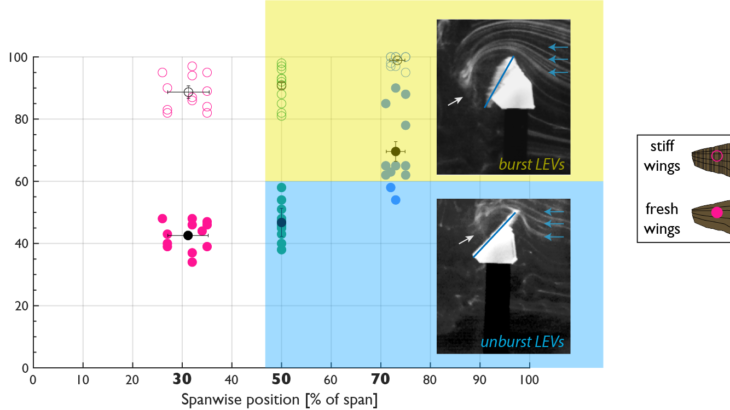The leading-edge vortex (LEV) is a well-known flight mechanism used by flapping insects, but the interplay between the bound LEV and the flexible wing it attaches to is not yet understood. On rigid wings, the LEV bursts but remains attached at Re~O(103), however this has not been seen on flexible insect wings in the same Reynolds number scale. Vortex bursting is defined as a sudden increase in leading-edge vortex area, such that the LEV diameter reaches the trailing-edge of the wing. The LEV is considered the dominate force-generating mechanism for insects at Re~O(103) and force production increases with decreasing wing flexural stiffness, so LEV bursting on insect wings would not be surprising. However, the lack of observed LEV bursting on real flapping insects suggests the material properties of natural wings may influence aerodynamic performance.
To study LEV bursting at insect-scale, we mounted real hawkmoth wings onto a motor that revolves at a constant frequency and generates a coherent LEV. Using smoke-wire visualization, we observed the qualitative structure of the LEV and measured the diameter relative to the wing chord length. On freshly-mounted wings, LEV diameter is consistently 60% or less than the local chord length with well-defined re-attachment streaklines (see figure). After desiccating, the wings stiffen in both the chord- and spanwise directions, and the LEV formed on stiffened wings has a diameter of at least 80% of the local chord length with disrupted re-attachment streaklines (see figure). The increase in wing flexural stiffness leads to the formation of a burst leading-edge vortex. Our results highlight an underappreciated connection between wing flexibility and aerodynamics. A more flexible wing may allow for greater force production without bursting due to a broader dynamic range of angle of attack (AoA) along the wingspan. As LEV size increases during the wingstroke, local changes in AoA could compensate for the corresponding decrease in vorticity. Our results indicate that the flexibility of insect wings has both kinematic and aerodynamic consequences.
